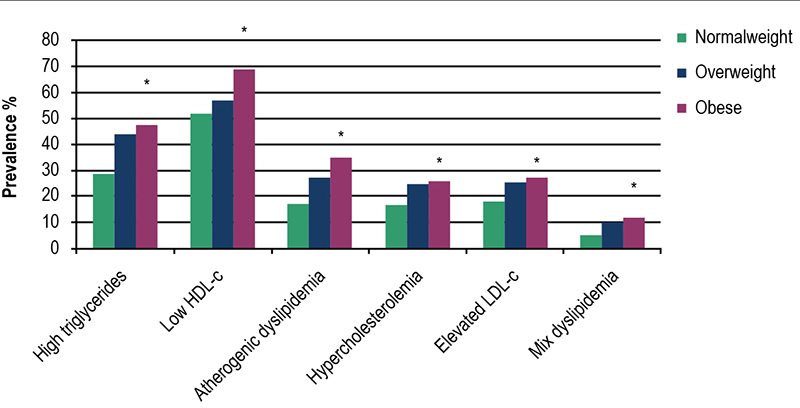Volume 110, Nº 1, January 2018
DOI: http://www.dx.doi.org/10.5935/abc.20170180
ORIGINAL ARTICLE
Prevalence of Dyslipidemias in Three Regions in Venezuela: The VEMSOLS Study Results
Juan P. González-Rivas
Ramfis Nieto-Martínez
Imperia Brajkovich
Eunice Ugel
Alejandro Rísquez

Figure 1 – Prevalence of dyslipidemia by nutritional status. *Difference in the prevalence of dyslipidemia according to nutritional status using Chi-square (p < 0.01). High triglycerides: 150 mg/dL; low HDL-c: < 40 mg/dL in men and < 50 mg/dL in women; atherogenic dyslipidemia: triglycerides = 150 mg/dL + low HDL-c; hypercholesterolemia: total cholesterol = 240 mg/dL; elevated LDL-c: = 160 mg/dL; mixed dyslipidemia: triglycerides = 150 + total cholesterol = 240 mg/dL.
Abstract
Background: The prevalence of dyslipidemia in multiple regions of Venezuela is unknown. The Venezuelan Metabolic Syndrome, Obesity and Lifestyle Study (VEMSOLS) was undertaken to evaluate cardiometabolic risk factors in Venezuela.
Objective: To determine the prevalence of dyslipidemia in five populations from three regions of Venezuela.
Methods: During the years 2006 to 2010, 1320 subjects aged 20 years or older were selected by multistage stratified random sampling from all households in five municipalities from 3 regions of Venezuela: Lara State (Western region), Merida State (Andean region), and Capital District (Capital region). Anthropometric measurements and biochemical analysis were obtained from each participant. Dyslipidemia was defined according to the NCEP/ATPIII definitions.
Results: Mean age was 44.8 ± 0.39 years and 68.5% were females. The prevalence of lipids abnormalities related to the metabolic syndrome (low HDL-c [58.6%; 95% CI 54.9 – 62.1] and elevated triglycerides [39.7%; 36.1 – 43.2]) were the most prevalent lipid alterations, followed by atherogenic dyslipidemia (25.9%; 22.7 – 29.1), elevated LDL-c (23.3%; 20.2 – 26.4), hypercholesterolemia (22.2%; 19.2 – 25.2), and mix dyslipidemia (8.9%; 6.8 – 11.0). Dyslipidemia was more prevalent with increasing body mass index.
Conclusion: Dyslipidemias are prevalent cardiometabolic risk factors in Venezuela. Among these, a higher prevalence of low HDL is a condition also consistently reported in Latin America. (Arq Bras Cardiol. 2018; 110(1):30-35)
Keywords: Dyslipidemias / epidemiology; Cardiovascular Diseases; Risk Factors; Stroke / mortality; Obesity; Metabolic Syndrome.















